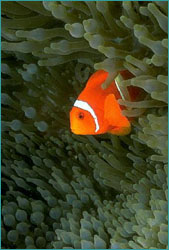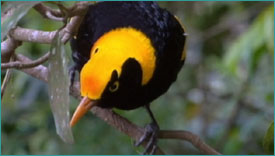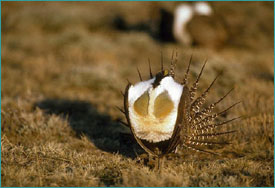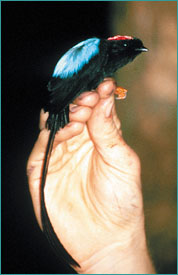 |
 |
|
Creature Courtship
Part 2 | Back to Part 1
The meek shall inherit
While sexual selection has favored the biggest individuals in species like elephant
seals and elk, sometimes tremendous size can work against its owner. Bull
elephant seals, for instance, can reach five times the weight of their mates,
and among the northern subspecies, roughly one in 1,000 cows dies of
suffocation while copulating with such behemoths. Though this death rate is
low, Mother Nature appears to have taken notice and placed a possible check on
the evolutionary trend toward Brobdingnagian. While beachmasters are battling
it out, smaller males are sometimes able to snatch sex from cows apparently
willing to forgo the biggest for the craftiest.
|  Gender-jumper extraordinaire, a clownfish hovers amid the
protective arms of a sea anemone.
Gender-jumper extraordinaire, a clownfish hovers amid the
protective arms of a sea anemone.
|
Biologists have recently identified a similar strategy of trumping the
Schwarzeneggers of one's kind in species a fish found in lakes along Africa's
Great Rift Valley. The fish in question is the shell-brooding cichlid
Lamprologus callipterus. Proportionally, this species boasts the largest
males in the animal kingdom; mature males are up to 30 times the size of their
mates. These comparatively massive males fill their lake-bottom territories
with empty aquatic snail shells. Interested females enter the shells and spawn,
while the giants hover outside, spewing sperm all over the place.
These males might seem to have it made, yet L. callipterus features
another kind of male, one that goes in for brains over brawn. Looking for all
the world like a nonbreeding female, this David swims unmolested into an
occupied shell and, unbeknownst to the Goliath hanging around outside,
fertilizes the female, ensuring a future for his genes.
The male clown fish has evolved an even more ingenious means of getting the
girl: He becomes one. Among clown fish, which form monogamous pairs, the female
is heftier than the male, but if she dies or disappears, the male puts on
weight, changes sex, and bonds with a new male partner.
Looking good
While gender-jumping is common among fish (though it usually happens in the opposite
direction, from female to male), most males in the animal world don't have such a
convenient option. And judging from appearances, many males would just as soon
not have to grapple with others of their gender. These males eschew Darwin's
first kind of sexual selection for his second. On the surface, bright colors,
fancy appendages, and flashy displays may seem a kindler, gentler form of
competition than that evinced among those built for armed combat. But the drive
for success is no less steely.
 Striking color combinations are de rigueur among males of many bird species, including this regent bowerbird.
Striking color combinations are de rigueur among males of many bird species, including this regent bowerbird.
|
|
Males in many species attract members of the opposite sex with dazzlingly
colored feathers, skin, or other body parts, which put comparatively drab
females of the same species to shame. Such color dimorphism is particularly
prevalent among birds. Many species show it, from such commonly seen birds as
the cardinal to the elusive quetzal, the most strikingly hued bird in the
Americas. The males of this species have flaming red crests and emerald tail
feathers almost three feet long, neither of which the females possess. That's
because such structures—arguably exemplified by the sexual billboard that is
the peacock's train in full display—are another attribute males have evolved
over the eons to excel in the mating game.
Even the most foppish males seem to realize, however, that beauty is only skin
deep, so they combine appearances with action. The cardinal lures the female
with a series of calls and gifts of tasty sunflower seeds. The quetzal courts
with a painstaking song-and-dance routine. Even the lordly peacock shakes its
brilliant billboard for added effect.
|  Erect and fastidious as a Buckingham Palace guard, a male sage grouse prepares
to parade, his head all but lost in a bravura display of brawn.
Erect and fastidious as a Buckingham Palace guard, a male sage grouse prepares
to parade, his head all but lost in a bravura display of brawn.
|
Holding courtship
Some
of these ritualized courtship displays can be quite involved. On the western
prairies of North America, for instance, male sage grouse congregate on vast
display grounds, where they strut their stuff before females. Mate markets of
this sort are common among birds; ornithologists know them as "leks," which
comes from a Swedish word for play.
Each sage grouse male is a wonder of pumped-up masculinity. Standing tall on
his patch of preferably raised ground, he holds his wings at his sides like
medieval shields, puffs out his robust chest of downy white feathers, throws up
a daunting array of pointed tail feathers, and begins to stomp vigorously on
the ground. (The bird's singular two-step inspired the foot-stomping ceremonial
dances of the Sioux Indians.)
Getting worked up, the grouse then takes a few steps, draws back his head, and
rapidly deflates a pair of scrotal-like air sacs jutting from his chest. The
resulting "plop" can be heard several hundred yards away. At the same time, the
bird briskly rubs his breast feathers against the wings at his side, generating
a swishing sound. When this sequence is finished, he stands still as a statue
for a few moments, then repeats the performance, eager to have nearby hens take
notice.
As with elephant seals, the payoff is tremendous for the cock that impresses
the most hens. On one such display ground, for example, a single male sage
grouse enjoyed fully three fourths of 174 couplings.
 One of the most accomplished acrobats in the avian world: the male long-tailed manakin.
One of the most accomplished acrobats in the avian world: the male long-tailed manakin.
|
|
Team work
While
the sage grouse lek has males fervently competing with one another, the lek of
the long-tailed manakin, a diminutive bird found in the rainforests of Costa
Rica, is altogether different. In this lek, two male manakins cooperate
with each other so that the dominant one of the pair can mate with a smitten
female.
The display begins with the two males patiently perched on a horizontal branch
near the ground, calling for females with a distinct toe-le-doe whistle.
When a female lands on the branch, indicating she's ready to be courted, the
two males, which are black with turquoise backs, crimson crowns, and twin tail
feathers as long as their bodies, launch into a prolonged acrobatic display,
whistling their flute-like call all the while. They step daintily and hop
energetically; they somersault and leap-frog; they take turns hovering in the
air.
As the tempo picks up, the males emit a buzzing sound, and the female becomes
more and more excited. At some critical point in the crescendo, the leading
male utters a shrill cry; this is the lesser male's cue to make himself scarce.
Alone at last, the vanquisher performs a brief dance before his prize and then
quickly mounts her.
The long-tailed manakin presents a rigorous test of Darwin's theory of sexual
selection. Not only have males evolved a handsome dress code, including radiant
colors and lengthy tail, but they also dance to beat the band. They'll go on
sometimes for 20 minutes, proving just how fit they are. On top of that, if the
pas de deux is successful, only the lead male gets the spoils. How can the
subordinate male's costly extras and exhausting performance possibly help him
in the survival of the fittest if he knows even before he begins a dance that
he has no chance of mating? Is it all for naught?
Not at all. He learns the ropes, so that when the dominant male dies or becomes
less sprightly with age, his apprentice can take over the lek or perhaps form
his own. Nature has it all figured out.
Peter Tyson is editor in chief of NOVA Online.
Further reading
A Natural History of Sex: The Ecology and Evolution of Sexual Behavior,
by Adrian Forsyth. New York: Scribner's, 1986.
Battle of the Sexes: The Natural History of Sex, by John Sparks. New
York: TV Books, 1999.
The Ant and the Peacock: Altruism and Sexual Selection From Darwin to
Today, by Helena Cronin. New York: Cambridge University Press, 1991.
Sexual Strategy, by Tim Halliday. Chicago: University of Chicago Press,
1980.
Photo credits
On the Trail of the Bowerbird |
Are Bowers Art? |
Creature Courtship
Bowerbird Matching Game |
Resources |
Teacher's Guide
Transcript |
Site Map |
Flying Casanovas Home
Search |
Site Map |
Previously Featured |
Schedule |
Feedback |
Teachers |
Shop
Join Us/E-Mail |
About NOVA |
Editor's Picks |
Watch NOVAs online |
To print
PBS Online |
NOVA Online |
WGBH
© | Updated December 2001
|
|
|
|